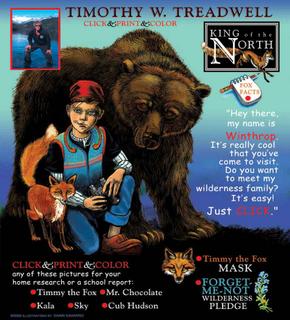Penguins Don't Love and Neither Do Grizzlies
After I watched March of the Penguins, I thought I should write a little piece about it. It was a beautifully filmed documentary, narrated sweetly by Morgan Freeman in his familiar sleepy bass tones. The scenery was breathtaking. The cold and the silence were almost palpable. The story held many lessons about the tenacity of wild creatures whose only purpose in life is to eat, survive and reproduce. I could forgive in this wonderful film the very silly references to romance and love, and even Mr. Freeman seemed to be reading that part of the script with a wry smile and tongue in cheek.
But then I watched Grizzly Man, the brilliant and terrifying documentary compiled by Werner Herzog about Timothy Treadwell's disastrous "love" affair with the planet's most dangerous predators. Better writers have already expounded on Treadwell's obvious mental health issues, his megalomania, his paranoia, his self-centeredness. I agree that the guy clearly had a superiority complex and lots of emotional stuff that led him away from the world of people and toward a fantasyland of "into the wild" isolation.
I also see a parallel between Treadwell's doomed devotion to the grizzlies and the warm-fuzzy rendition of penguin love. And for good measure, I'll throw in a connection to the Disney/Pixar animal movies, anthropomorphizational fluff like Lion King, Jungle Book, Finding Nemo, all the way back to 101 Dalamations and Bambi.
Look, I see the value of entertainment for children that's benign and clean and maybe teaches some lessons about kindness and humanity. I know that stuff is hard to find these days, and we all want to protect kids from the harsh realities of life until the very last minute. But in an increasingly urban society, I think we do a disservice to kids if we don't teach them a few things about the food chain, and the brutal truth of nature. When you don't grow up in places where people hunt or work farms, when you get your meat in the frozen food aisle or at McDonalds, you sort of miss the point.
I realize that Timothy Treadwell must have known a good bit about the Katmai grizzlies to survive among them for as long as he did. He was probably more than just lucky, and had obviously developed some skills that may have protected him in some situations.
But the film bits Herzog included in Grizzly Man also displayed way too much cutesy, lovey-dovey baby-talk, and sometimes it looked like Treadwell really believed he had the upper hand over these devastatingly powerful animals. It worries me that part of Treadwell's work included presentations to children, and I hope that he taught those kids as much about the real-life danger of wild animals as he did about their beauty. I hope he didn't instill in yet more children the ridiculous notion that these bears "loved" him, that wild animals are capable of feeling human emotions like love and affection and friendship.
In the end, Timothy Treadwell was eaten by a grizzly bear. That's the ultimate lesson here, and I hope that his legacy teaches it.

But then I watched Grizzly Man, the brilliant and terrifying documentary compiled by Werner Herzog about Timothy Treadwell's disastrous "love" affair with the planet's most dangerous predators. Better writers have already expounded on Treadwell's obvious mental health issues, his megalomania, his paranoia, his self-centeredness. I agree that the guy clearly had a superiority complex and lots of emotional stuff that led him away from the world of people and toward a fantasyland of "into the wild" isolation.
I also see a parallel between Treadwell's doomed devotion to the grizzlies and the warm-fuzzy rendition of penguin love. And for good measure, I'll throw in a connection to the Disney/Pixar animal movies, anthropomorphizational fluff like Lion King, Jungle Book, Finding Nemo, all the way back to 101 Dalamations and Bambi.
Look, I see the value of entertainment for children that's benign and clean and maybe teaches some lessons about kindness and humanity. I know that stuff is hard to find these days, and we all want to protect kids from the harsh realities of life until the very last minute. But in an increasingly urban society, I think we do a disservice to kids if we don't teach them a few things about the food chain, and the brutal truth of nature. When you don't grow up in places where people hunt or work farms, when you get your meat in the frozen food aisle or at McDonalds, you sort of miss the point.
I realize that Timothy Treadwell must have known a good bit about the Katmai grizzlies to survive among them for as long as he did. He was probably more than just lucky, and had obviously developed some skills that may have protected him in some situations.
But the film bits Herzog included in Grizzly Man also displayed way too much cutesy, lovey-dovey baby-talk, and sometimes it looked like Treadwell really believed he had the upper hand over these devastatingly powerful animals. It worries me that part of Treadwell's work included presentations to children, and I hope that he taught those kids as much about the real-life danger of wild animals as he did about their beauty. I hope he didn't instill in yet more children the ridiculous notion that these bears "loved" him, that wild animals are capable of feeling human emotions like love and affection and friendship.
In the end, Timothy Treadwell was eaten by a grizzly bear. That's the ultimate lesson here, and I hope that his legacy teaches it.



